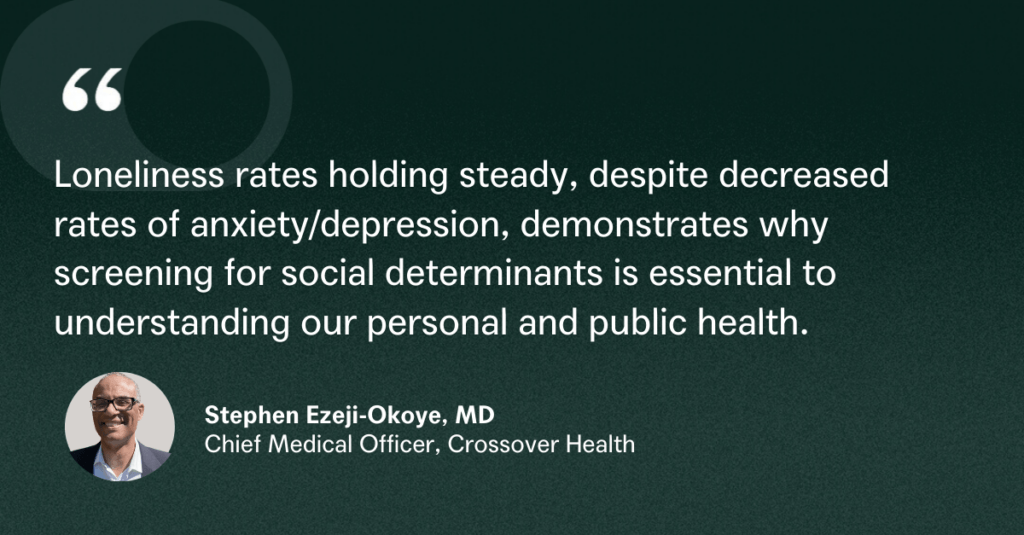
Blog
Following the “Dark Thread” of Loneliness
By Stephen Ezeji-Okoye, MD
Years before the COVID-19 pandemic, loneliness was being flagged by then U.S. Surgeon General Vivek Murthy as a rising “epidemic” and public health concern. Loneliness, he warned, runs “like a dark thread” through other physical and mental issues such as addiction, anxiety, and depression – its effect adding up to a lifetime mortality risk equal to that of obesity or smoking a pack of cigarettes a day.
While the social isolation of the pandemic has unquestionably added fuel to this slow-burning fire, it has also done us a great service by dragging loneliness and other social determinants of health out of the shadows, revealing the many ways social, environmental, mental and physical health factors converge and conspire against our personal and public health.
So, now that we see these risks in a new light, and recognize the interconnectedness, what do we do about it? How do we follow and connect these threads to promote more comprehensive health?
Screening for “the other 80%”
At Crossover Health, our approach is rooted in the understanding that the traditional sick care model only captures some 20% of what influences people’s health. We therefore make it a priority to ask about, and do whatever we can to address, the other 80%. As part of our “Be Well” model, we regularly screen members for a set of behavioral/social indicators, including alcohol use, partner violence, depression and anxiety, housing insecurity, and financial instability.
In January 2021, with the pandemic taking a heavy toll on mental health, we began screening for loneliness using the well-established three-question UCLA Loneliness Scale. As social determinants go, loneliness is often misunderstood and easily missed. Unlike social isolation, which can be observed and measured, loneliness is subjective – often defined as the self-perceived gap between the expectations and reality of one’s social connections. Due to stigma and shame, it’s often hidden from view. And five years after Murthy brought it to the highest levels of public awareness, few primary care physicians screen for it today – an unfortunate gap and missed opportunity.
So what did we learn from asking about loneliness? Of the more than 26,000 members we’ve screened since we began nearly a year and a half ago, 1 in 4 screened positive for loneliness (scoring 6-9 on the UCLA scale). Of those who reported being lonely, 49% also reported being anxious, depressed, or both. Interestingly, as shown in the figure below, while anxiety and depression steadily tapered off after late 2020, corresponding with initial rollout of COVID vaccines, rates of loneliness are holding stubbornly steady.
So how do we use this data to inform care and close gaps? It depends very much on the interplay of these behavioral and social factors. Someone who, for example, screens in the mild range for anxiety and depression and also screens positive for loneliness will be flagged for intervention and most likely referred for therapy. In this case, loneliness can be seen and addressed as a contributing or compounding factor.
But it’s just as critical to have captured the nearly 3,300 members who only reported experiencing loneliness. For them, loneliness may be an early warning signal or an indicator of more serious health concerns that have yet to surface. For example, I’ve seen members who are married or in a domestic partnership screen high for loneliness, raising concerns of potential detachment or other brewing relationship issues. Likewise, someone who screens in the low range for Intimate Partner Violence but high for loneliness might raise a flag for strain in the relationship we might not otherwise see. At Crossover we use this information to direct people to health coaches, offer a personalized curriculum or other resources, or simply begin a conversation with patients to learn more. In this way, consistent with our team-based integrated care model, we take the time to proactively address the whole-person needs of our members, building trust by doing what’s right for them.
In a time when not much seems to be predictable, one thing we can be certain of is that loneliness isn’t going away anytime soon. If anything, as our data shows, it seems to be maintaining a steady grip even as many pandemic restrictions subside. Having brought loneliness out into the light, we now need to systematically address it along with the rest of the 80% of factors that add up to being well. We won’t accomplish this by continuing to address these factors in isolation. To follow the thread of loneliness and understand how it weaves through the fabric of Primary Health, we must take a truly comprehensive, integrated approach to care. Doing so will allow us to have patient conversations we wouldn’t otherwise have, spot signals we would otherwise miss, and intervene early to keep people well.
___
About the Author

As Chief Medical Officer at Crossover Health, Dr. Ezeji-Okoye oversees the company’s national Medical Group, consisting of interdisciplinary care teams who deliver Crossover’s Advanced Primary Health model to members. He has a passion for population health and redesigning systems to drive improvements in quality and efficiency beyond medical intervention.
